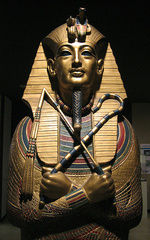
For years, scientists have tried to unravel ancient clues as to why the boy king of Egypt, who reigned for 10 years, died at the age of 19.
Several theories have been put forth. One was that he was killed by a blow to the head. Another put the blame on a broken leg. As recently as June, German scientists said they believe there is evidence he died of sickle cell disease.
A team of researchers using a combination of CT scans, DNA testing and archaeological information now believe his fate was sealed by the fact that his parents were brother and sister. His body was just not built to last.
The research was conducted by archaeologists and geneticists who started performing CT scans on Tutankhamun five years ago and found that he was not killed by a blow to the head, as previously though. That same team began doing DNA research on Tut's mummy, as well as the mummified remains of other members of his family, in 2008.
DNA finally put to rest questions about Tut's lineage, proving that his father was Akhenaten and that his mother was not one of Akhenaten's known wives. His mother was one of Akhenaten's five sisters, although it is not known which one.
New CT images discovered congenital flaws, which are more common among the children of incest. Siblings are more likely to pass on twin copies of harmful genes, which is why children of incest more commonly manifest genetic defects.
Among the new discoveries is that Tut had a clubbed foot and that one toe was missing a bone and bones in part of his foot were destroyed by necrosis. It was previously thought that the staffs found in his tomb were symbols of power. The scientists involved in this new research now believe he may have used them as walking sticks.
They added he likely had a partially cleft palate, which is also a congenital flaw.
They also discovered that new bone growth had occurred in response to the necrosis, proving the condition was present during his lifetime and adding weight to the argument that the boy king had difficulty walking.
They also noted that while the bone disease would have been crippling, it would not have been fatal. His mummy was tested for various infectious diseases. They discovered DNA from several strains of a parasite proving he was infected with the most severe strain of malaria several times in his short life. Malaria can trigger circulatory shock or cause a fatal immune response in the body, either of which can lead to death.
It is just as likely, however, that Tutankhamun's health was compromised at conception, said researchers. "Perhaps he struggled against others [congenital flaws] until a severe bout of malaria or a leg broken in an accident added one strain too many to a body that could no longer carry the load," wrote Zahi Hawass, an archaeologist involved in the research.
The research is ongoing. They are now trying to determine the identities of mummified females found in Tut's tomb. One mummified fetus is Tut's daughter. There is only partial data now available for two female adults. One of them may be the infants' mother and thus, Tut's wife. It is thought that she might be the child of Akhenaten and Nefertiti, which would make her Tut's half-sister.



Reader Comments
to our Newsletter